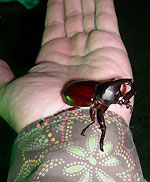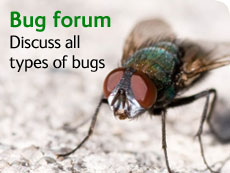Rhinoceros beetle CT scan
Images captured from the Museum's micro-CT scanner
Watch closely as this impressive beetle specimen rotates to reveal its intricate internal structure.

This rhinoceros beetle, Xylotrupes gideon ssp. kaszabi, is an endemic subspecies to Lanyu Island, Taiwan.
What is this?
This is a rhinoceros beetle, a species of the genus Oryctes. They get their name from the long horn on their head, which is much larger in the male and is probably used for fighting.
A series of images of the beetle were collected using the Museum's micro-CT scanner and joined together to form this short video. This state-of-the-art instrument works in much the same way as a hospital scanner and uses X-rays to make digital images of objects in 3D.
These 'virtual specimens' can be manipulated and digitally dissected on a computer to reveal internal structure and organisation.
Where are rhinoceros beetles found?
There are 38 species of rhinoceros beetles, most of them living in Africa with a few in Arabia and Asia and one species, the European rhinoceros beetle, penetrating as far north as Scandinavia. None occur in Britain.
Using CT Scanning in Museum research
Sometimes it is quite difficult to identify species of rhinoceros beetle. Identification is important, to know, for example, whether a specimen belongs to a pest species or a rare, harmless species. Museum scientists work with entomologists and agriculturalists all over the world, and they are always exploring new tools like CT scanning to help with their work.
Pests
Some species of rhinoceros beetles are serious pests of palm trees. The adults cause the damage, boring into the palm’s crown and reducing fruit yield by 10-20%. Sometimes wind, fungi or other insects can enter through the beetle’s holes, and kill the trees. Oil palm, coconut palm and date palm are all affected. One species was spread around the Pacific Islands during World War II, and is damaging palm agriculture there. It is important to understand these pests to help to control them.
Rare species
However, some species are rare. The European rhinoceros beetle, one of Europe’s largest insects, is legally protected in some countries, and some poorly known species that live in tropical rainforests may be in danger of extinction because of deforestation. We need to learn more about these rare species, so we can help preserve them.
Edible larvae
Larvae of rhinoceros beetles are fat white grubs, which bore in rotten wood, humus and compost. In many parts of the world they are collected as a high protein food, and in parts of Africa they are used to make an edible oil that is rich in unsaturated fats.
